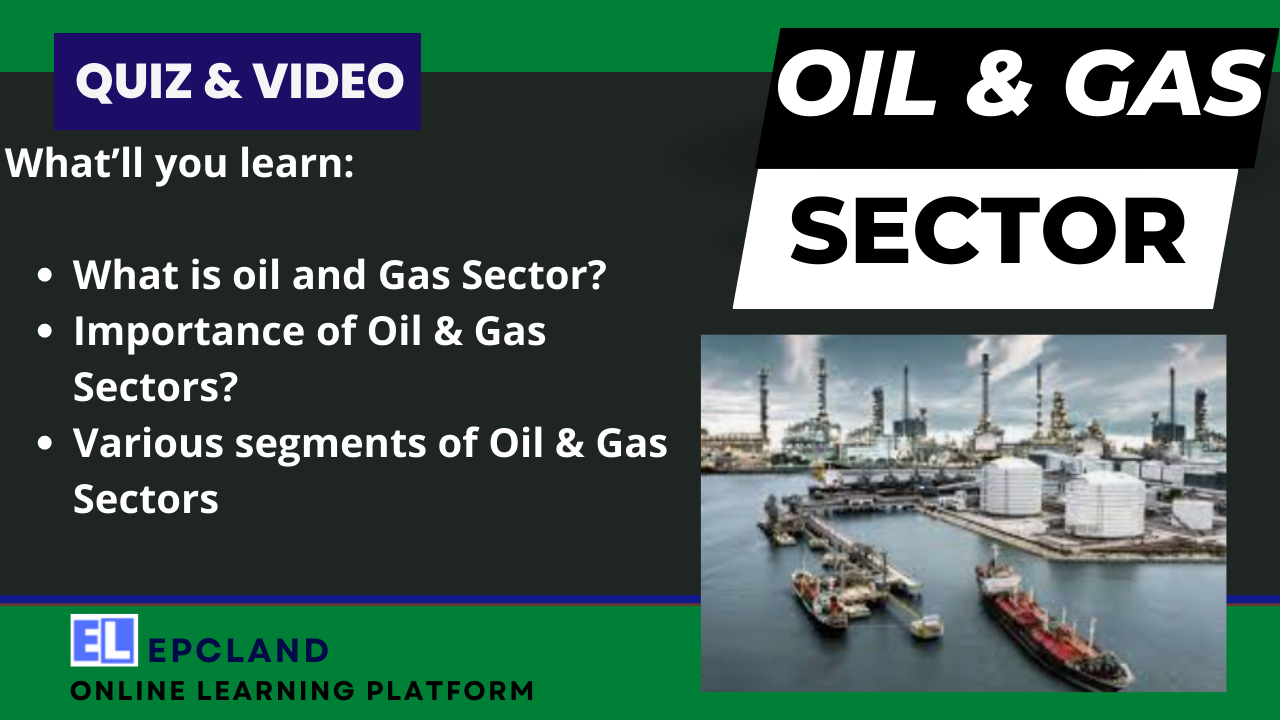Introduction
The global economy relies heavily on the Oil & Gas sector, a cornerstone of modern industrialization and energy supply. This industry not only powers vehicles and heats homes but also serves as a pivotal force driving economic growth, technological innovation, and geopolitical dynamics. In this comprehensive exploration, we delve into the multifaceted world of the Oil & Gas sector, uncovering its trends, challenges, and future prospects.
Table of Contents
Don’t miss the Complete Course on Piping Engineering: Check Now
By EPCLand.com
The Importance of Oil & Gas
Understanding the Energy Backbone
Oil and gas products are the lifeblood of the modern world, serving as the primary energy source for transportation, electricity generation, and various industrial processes. The sector’s pivotal role in driving economic development and global connectivity cannot be understated.
Economic Significance
The Oil & Gas industry is a major contributor to national and global economies. It generates revenue, creates jobs, and influences foreign policy decisions. Oil-exporting nations often experience significant economic impact based on fluctuations in global oil prices.
Trends Shaping the Industry
Transitioning to Renewable Energy
As environmental concerns grow, there is a noticeable shift towards renewable energy sources. The Oil & Gas sector is increasingly exploring and investing in clean technologies, such as solar, wind, and biofuels, to diversify their portfolios and mitigate climate change risks.
Digital Transformation and Automation
Technology is reshaping the way Oil & Gas companies operate. From advanced sensors in drilling equipment to data analytics for predictive maintenance, digitalization is streamlining operations, improving safety, and optimizing resource allocation.
Enhanced Exploration Techniques
The search for new oil and gas reserves has led to innovative exploration methods, including deep-sea drilling and hydraulic fracturing (fracking). These techniques have expanded the industry’s ability to access previously untapped resources.
Challenges and Concerns
Environmental Sustainability
The Oil & Gas sector faces increasing pressure to reduce its environmental impact. The extraction, refining, and burning of fossil fuels contribute to air and water pollution, as well as greenhouse gas emissions. Balancing energy demand with sustainability remains a complex challenge.
Geopolitical Uncertainties
Oil and gas reserves are distributed unevenly across the globe, leading to geopolitical tensions and conflicts. Supply disruptions caused by political instability can significantly impact global energy markets and prices.
Price Volatility
The Oil & Gas industry is known for its price volatility. Factors such as geopolitical events, supply-demand dynamics, and economic conditions can cause rapid fluctuations in oil and gas prices, affecting both producers and consumers.
breakdown of some key segments:
Exploration and Production (Upstream)
The upstream segment involves the exploration, drilling, and extraction of oil and gas reserves from the Earth’s crust. This includes:
- Exploration: Companies search for new oil and gas reserves by conducting geological surveys, seismic studies, and exploratory drilling.
- Drilling: Once potential reserves are identified, drilling operations are initiated to access the resources. This includes onshore and offshore drilling.
- Production: Extracted oil and gas are processed and prepared for transportation and refining. This segment is known for its inherent risks and challenges, including reservoir complexities and operational hazards.
Refining and Processing (Midstream)
The midstream segment focuses on processing, transporting, and storing crude oil and natural gas. Key activities include:
- Refining: Crude oil is refined into various products such as gasoline, diesel, jet fuel, and petrochemical feedstocks.
- Pipelines and Transportation: The transportation of oil and gas through pipelines, ships, and other means is a critical aspect. Midstream companies operate pipelines and terminals to move these products efficiently.
- Storage: Storage facilities are essential for managing fluctuations in supply and demand. Tanks and terminals store both raw materials and finished products.
Distribution and Marketing (Downstream)
The downstream segment involves the distribution, marketing, and sale of refined products to end consumers. This includes:
- Distribution: Refined products are distributed to retail outlets, industrial consumers, and other end users through a network of trucks, pipelines, and other transportation methods.
- Marketing: Companies establish brands and market their products to consumers. Gas stations, convenience stores, and other retail locations are part of this segment.
- Retail: Gas stations and retail outlets provide a direct link between the industry and consumers. They offer a range of petroleum products and services.
Petrochemicals and Chemicals
This segment involves the production of petrochemicals and chemicals derived from oil and natural gas. These chemicals are used in a wide range of industries, including plastics, pharmaceuticals, textiles, and more.
LNG (Liquefied Natural Gas)
LNG involves the liquefaction of natural gas for efficient transportation and storage. LNG facilities convert natural gas into a liquid state, reducing its volume and enabling long-distance transport.
Offshore and Deepwater Operations
Offshore operations include exploration, drilling, and production activities conducted in offshore environments, such as oceans and seas. Deepwater operations involve drilling and producing hydrocarbons in water depths exceeding 500 feet.
Oilfield Services
Oilfield services companies provide specialized equipment, tools, and expertise to support exploration and production operations. These services include drilling, well maintenance, reservoir analysis, and more.
Renewable Energy and Sustainability Initiatives
As the push for clean energy intensifies, many Oil & Gas companies are diversifying into renewable energy sources such as solar, wind, and biofuels. This segment focuses on sustainable energy production and reducing the industry’s environmental impact.
Future Prospects and Innovations
Advancements in Alternative Fuels
The future of the Oil & Gas sector lies in embracing alternative fuels and energy sources. Biofuels, hydrogen, and synthetic fuels are gaining traction as potential substitutes, providing cleaner energy options and reducing carbon emissions.
Carbon Capture and Storage (CCS)
To address emissions, Carbon Capture and Storage technology is gaining prominence. This process involves capturing carbon dioxide emissions from industrial processes and power plants and storing them underground, thereby mitigating the impact on the atmosphere.
Sustainable Operations
Companies are adopting sustainable practices throughout their operations. From minimizing waste and emissions to investing in renewable energy projects, these efforts not only align with environmental goals but also enhance their social responsibility image.
FAQs
Q1: How does the Oil & Gas sector impact the global economy? A1: The sector generates revenue, creates jobs, and influences foreign policy decisions, playing a significant role in economic development.
Q2: What are the emerging trends in the industry? A2: Trends include transitioning to renewable energy, embracing digital transformation, and enhancing exploration techniques.
Q3: What challenges does the sector face? A3: Challenges include environmental sustainability, geopolitical uncertainties, and price volatility.
Q4: How is the industry addressing environmental concerns? A4: The sector is investing in renewable energy sources, exploring carbon capture technologies, and adopting sustainable practices.
Q5: What does the future hold for the Oil & Gas sector? A5: The future involves adopting alternative fuels, implementing carbon capture and storage, and focusing on sustainable operations.
Conclusion
The Oil & Gas sector stands at a crossroads, with opportunities for innovation, sustainability, and adaptability. As the world transitions to cleaner energy sources and environmental consciousness grows, the industry must evolve to remain relevant and responsible. Through strategic investments, technological advancements, and a commitment to reducing its carbon footprint, the sector can contribute to a more sustainable energy landscape while continuing to power the global economy.
Recommended courses (Published on EPCLand)
- Basics of Piping Engineering
- Piping Layout Engineering
- Piping Material Engineering
- Piping Stress Analysis
- Complete Course on Piping Engineering
- Material Requisitions
- Piping Material Specifications
- Valve Material Specifications
Don’t miss the published articles on following:
Related Video
Attempt Quiz
Question 1:
Which fossil fuel is commonly extracted and processed in the Oil & Gas sector?
Explanation: Natural Gas is a fossil fuel commonly extracted and processed in the Oil & Gas sector, along with crude oil.
Question 2:
What is the primary use of crude oil extracted in the Oil & Gas sector?
Explanation: Crude oil extracted in the Oil & Gas sector is commonly used for manufacturing plastics, chemicals, and various petroleum-based products.
Question 3:
Which process is used to separate different hydrocarbons from crude oil?
Explanation: The process used to separate different hydrocarbons from crude oil is called refining. It involves various techniques to separate, purify, and transform the raw crude oil into valuable products.
Question 4:
What is the primary environmental concern associated with the Oil & Gas sector?
Explanation: The primary environmental concern associated with the Oil & Gas sector is greenhouse gas emissions, which contribute to climate change and global warming.
Question 5:
What role does hydraulic fracturing (fracking) play in the Oil & Gas sector?
Explanation: Hydraulic fracturing (fracking) is a method used in the Oil & Gas sector to extract oil and gas from underground rock formations by injecting high-pressure fluid to create fractures and release the hydrocarbons.



